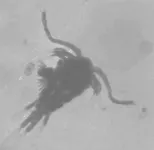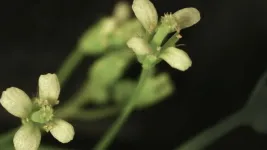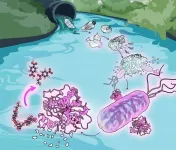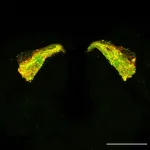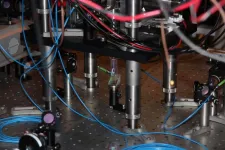(Press-News.org) Highlights:
Mycobacterium tuberculosis, which causes tuberculosis (TB), is a threat to public health.
A new study identified that a semi-synthetic compound can be derived from natural compounds and shows potent activity against M. tuberculosis, including multi-drug resistant strains.
This is a promising step toward new potent treatment for TB.
Washington, D.C.—A new study published in the American Society for Microbiology journal Microbiology Spectrum demonstrates that a novel semi-synthetic compound can be derived from natural compounds to produce potent activity against Mycobacterium tuberculosis, including multi-drug resistant strains. The new compound provides a promising chemical scaffold to develop new potent anti-tuberculosis drugs.
M. tuberculosis, the pathogen responsible for tuberculosis (TB), is the leading cause of bacterial disease-related death worldwide. Current antibiotic regimens for the treatment of TB are dated, require longer courses of treatment and risk the development of drug-resistance.
In the new study, researchers conducted a search for novel antibiotics targeting M. tuberculosis that could also be effective against drug-resistant strains. In drug discovery, a valuable place to start looking for new antibiotics is within the world of natural compounds produced by organisms such as plants, fungi and bacteria. Sanguinarine, a natural compound with known antimicrobial properties, is extracted from an herbaceous flowering plant native to North America. Sanguinarine has been used in traditional and alternative medicine for animals, but its toxicity makes it unfit to be used as a drug in humans.
The group of researchers redesigned sanguinarine using principles of medicinal chemistry to produce a more potent antibacterial compound with reduced toxicity. In studies in test tubes and in mice, the improved version of sanguinarine, called BPD-9, was capable of killing strains of M. tuberculosis that are resistant to all front-line antibiotics used in the clinics to treat TB. Moreover, BPD-9 was effective against non-replicating (dormant) and intracellular M. tuberculosis, which are 2 key aspects that limit the effectiveness of current anti-TB drugs. The researchers also found that BPD-9 was only active against pathogenic bacteria from the same genus as M. tuberculosis, which may spare the microbiome and other beneficial bacteria that most antibiotics harm.
“Our findings show a new chemical entity that has unique properties in combating Mycobacterium tuberculosis, which may be harnessed further for clinical translation,” said corresponding study author Jim Sun, Ph.D., Assistant Professor in the Department of Microbiology and Immunology at The University of British Columbia. “Our finding that the new compound is effective against other members of the Mycobacterium genus may also prove to be valuable in the fight against deadly lung infections caused by non-tuberculous mycobacteria, which are notoriously resistant to most antibiotics. It is also enticing to speculate that BPD-9 could be killing Mycobacterium tuberculosis in a way that is different than that of existing anti-TB drugs.”
The study was conducted in collaboration with the medicinal chemistry team of Weibo Yang, Ph.D. at the Shanghai Institute of Materia and Medica (Chinese Academy of Sciences) and bacterial genetics team of Marcel Behr, M.D., and Andréanne Lupien, Ph.D. at McGill University. The research was supported by grants from the Canadian Institutes of Health Research and the National Sanitarium Association.
###
The American Society for Microbiology is one of the largest professional societies dedicated to the life sciences and is composed of over 32,000 scientists and health practitioners. ASM's mission is to promote and advance the microbial sciences.
ASM advances the microbial sciences through conferences, publications, certifications, educational opportunities and advocacy efforts. It enhances laboratory capacity around the globe through training and resources. It provides a network for scientists in academia, industry and clinical settings. Additionally, ASM promotes a deeper understanding of the microbial sciences to diverse audiences.
END
Study identifies potential novel drug to treat tuberculosis
2024-10-03
ELSE PRESS RELEASES FROM THIS DATE:
UTEP study: Zooplankton go “Eew!” to cleaning feces contaminated water
2024-10-03
EL PASO, Texas (Oct. 3, 2024) – Scientists at The University of Texas at El Paso and Stanford University were recently surprised to find that the natural community of zooplankton — tiny, aquatic animals known to graze on bacteria — present in freshwater and saltwater do not clean water that is contaminated with fecal microorganisms.
The research, published today in the biology journal mSphere, reveals important insights about the limitations of zooplankton in treating bodies of water that have been contaminated with fecal organisms, the team said. A 2017 U.S. water quality inventory ...
FAU awarded $10M to train people with disabilities for in-demand tech jobs
2024-10-03
The rising demand for tech jobs presents an outstanding opportunity for growth and inclusivity in the industry. Developing accessible training programs tailored for individuals with disabilities can foster a more diverse workforce. Florida Atlantic University’s College of Education and the College of Engineering and Computer Science have received a $9,961,460 grant from the United States Department of Education’s Office of Special Education and Rehabilitative Services to increase the capacity and participation of transition-age youths and working-age adults with disabilities in high demand technology jobs locally and nationally. ...
Plants have a backup plan
2024-10-03
Tending a garden is hard work. Imagine it from the plants’ perspective. Each relies on fine-tuned genetic processes to pass down accurate copies of chromosomes to future generations. These processes sometimes involve billions of moving parts. Even the tiniest disruption can have a cascading effect. So, for plants like Arabidopsis thaliana, it’s good to have a backup plan.
“Chromosomes have to be accurately partitioned every time a cell divides,” explains Cold Spring Harbor Laboratory (CSHL) Professor and HHMI Investigator Rob Martienssen. “For that to happen, each chromosome has ...
Logic with light
2024-10-03
Increasingly complex applications such as artificial intelligence require ever more powerful and power-hungry computers to run. Optical computing is a proposed solution to increase speed and power efficiency but has yet to be realized due to constraints and drawbacks. A new design architecture, called diffraction casting, seeks to address these shortcomings. It introduces some concepts to the field of optical computing that might make it more appealing for implementation in next-generation computing devices.
Whether ...
Wastewater bacteria can breakdown plastic for food
2024-10-03
Researchers have long observed that a common family of environmental bacteria, Comamonadacae, grow on plastics littered throughout urban rivers and wastewater systems. But what, exactly, these Comamonas bacteria are doing has remained a mystery.
Now, Northwestern University-led researchers have discovered how cells of a Comamonas bacterium are breaking down plastic for food. First, they chew the plastic into small pieces, called nanoplastics. Then, they secrete a specialized enzyme that breaks down the plastic even further. Finally, the bacteria use a ring of carbon atoms from the plastic as a ...
Researchers study 3D printing tungsten parts for extreme conditions in nuclear reactors
2024-10-03
10-2-24
Contacts:
Sougata Roy, Mechanical Engineering, 515-294-5001, sroy@iastate.edu
Mike Krapfl, News Service, 515-294-4917, mkrapfl@iastate.edu
Researchers study 3D printing tungsten parts for extreme conditions in nuclear reactors
AMES, Iowa – Sougata Roy, who doesn’t study electrons or grids or wind turbines, has found a way to contribute to a clean-energy future.
“This work in advanced manufacturing, particularly in using additive manufacturing, is about making a difference,” ...
Promising ‘first’ in Alzheimer’s drug development
2024-10-03
EMBARGOED: NOT FOR RELEASE UNTIL THURSDAY 3 OCTOBER AT 07:00 ET (12:00 UK TIME)
An international team of researchers have made a promising breakthrough in the development of drugs to treat Alzheimer’s Disease.
For the first time, scientists have developed a drug that works on both major aggregation-promoting ‘hotspots’ of the Tau protein - addressing a critical gap in current treatments.
The drug, a peptide inhibitor called RI-AG03, was effective at preventing the build-up of Tau proteins - a key driver of neurodegeneration - in both lab and fruit fly studies.
The ...
Quantum researchers come up with a recipe that could accelerate drug development
2024-10-03
University of Copenhagen mathematicians have developed a recipe for upgrading quantum computers to simulate complex quantum systems, such as molecules. Their discovery brings us closer to being able to predict how new drugs will behave within our bodies and has the potential to revolutionize pharmaceutical development.
Developing a new drug can take more than a decade and cost anywhere from hundreds of millions to billions of euro — with multiple failed attempts along the way. But what if we could predict how a drug worked ...
Experts publish the latest guide for systematic reviews of preclinical research
2024-10-03
A new publication in Nature Reviews Methods Primers provides essential guidance for conducting rigorous systematic reviews on studies with animals and cells. It also highlights the benefits of these reviews, such as improving reproducibility and reducing animal use, and addresses potential pitfalls and recent advancements like review automation.
Systematic reviews synthesize existing evidence in a scientific field to answer specific research questions in a structured and unbiased way. With over 100 million animals used in scientific ...
Oyster reefs once thrived along Europe’s coasts – now they’re gone
2024-10-03
Oysters once formed extensive reefs along much of Europe's coastline – but these complex ecosystems were destroyed over a century ago, new research shows.
Based on documents from the 18th and 19th Centuries, the study reveals that European flat oysters formed large reefs of both living and dead shells, providing a habitat supporting rich biodiversity.
Today these oysters are mostly found as scattered individuals – but the researchers found evidence of reefs almost everywhere, from Norway to the Mediterranean, covering at least 1.7 million hectares, an area larger than Northern Ireland.
The research was ...
